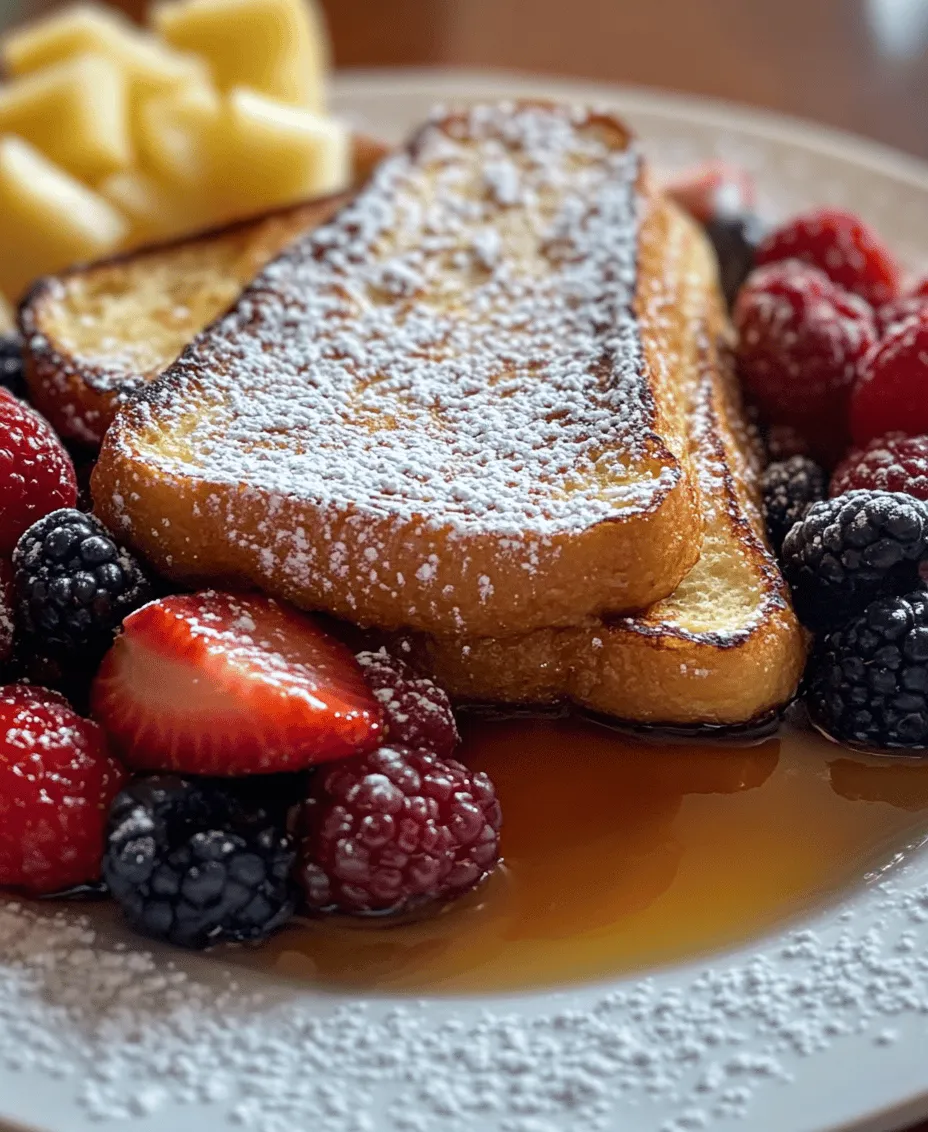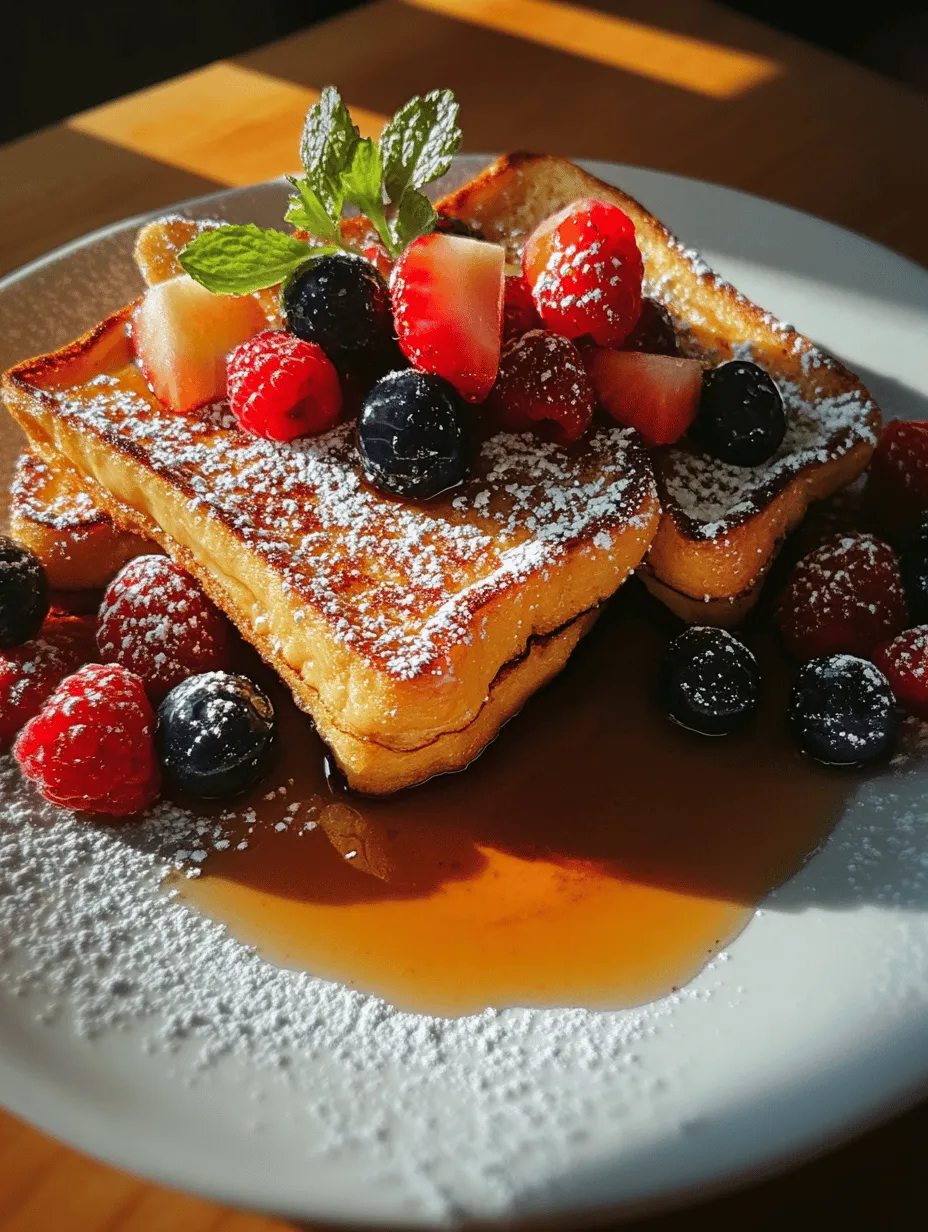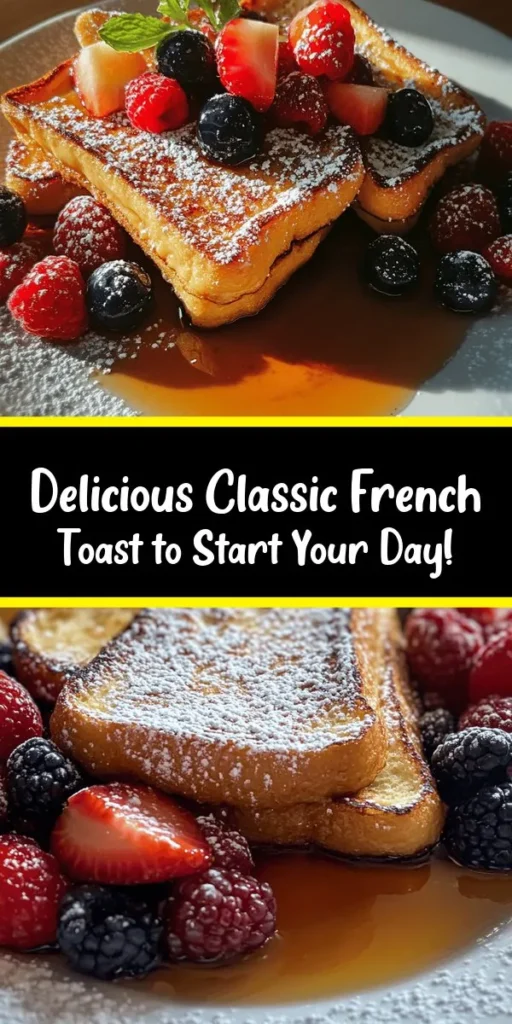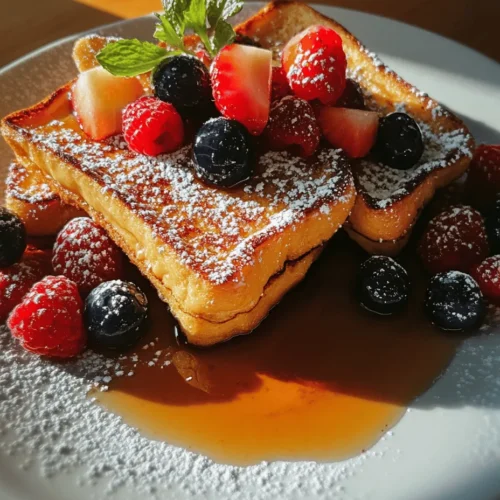Introduction
French toast is a beloved breakfast classic that has stood the test of time, transcending cultures and generations. This delightful dish, known for its crispy edges and soft, custardy center, is a comforting way to start any day. Among the myriad variations of French toast, the Classic French Toast Delight made with brioche or challah stands out for its unique texture and rich flavor profile. These types of bread elevate the dish to a gourmet level, making it not just a meal but an experience.
The beauty of this recipe lies in its simplicity. With just a handful of ingredients, you can whip up a batch of French toast that rivals any café or brunch spot. The joy of making French toast at home is not only in the cooking but also in the aroma that fills your kitchen, enticing everyone to gather around the table. Whether topped with a drizzle of maple syrup, a dusting of powdered sugar, or a handful of fresh berries, French toast offers endless possibilities to customize and impress.
In this article, we will explore the essential ingredients that make up the Classic French Toast Delight, understand the significance of choosing the right bread, and provide a detailed step-by-step guide to creating this breakfast favorite in your own kitchen.
Understanding the Ingredients
To create a perfect Classic French Toast Delight, it’s crucial to understand the role each ingredient plays in the dish. Here’s a closer look at the key components of this recipe:
Thick-Cut Bread
The foundation of any great French toast is the bread, and for this recipe, we recommend using either brioche or challah. Both options are enriched breads, meaning they contain a higher fat content due to the addition of eggs and butter. This results in a soft and fluffy texture that soaks up the custard mixture beautifully without becoming overly soggy.
– Brioche: This French bread is slightly sweet and incredibly soft, making it a popular choice for French toast. Its rich, buttery flavor enhances the overall taste of the dish.
– Challah: This traditional Jewish bread is also rich and slightly sweet, featuring a braided appearance that adds aesthetic appeal. Challah has a slightly denser texture compared to brioche, which allows it to hold up well during cooking.
Using thick-cut slices—around 1-inch thick—is essential as it provides the perfect balance between a custardy center and a crispy exterior. If the slices are too thin, they may disintegrate during the soaking and cooking process.
Eggs
Eggs are the binding agent in the custard mixture, providing richness and structure to the French toast. They help create that signature custardy texture that defines a good French toast. When beaten and combined with the other ingredients, eggs not only add flavor but also help the bread maintain its integrity during cooking.
Whole Milk
Whole milk adds creaminess and moisture to the egg mixture. It enhances the overall flavor and richness of the French toast. While you could use lower-fat milk, whole milk provides the best texture and taste, ensuring that each bite is indulgent and satisfying.
Vanilla Extract
Vanilla extract is a key ingredient that elevates the flavor profile of the French toast. It adds warmth and depth, making the dish taste more complex and inviting. For the best results, use pure vanilla extract rather than imitation, as it significantly enhances the overall flavor.
Ground Cinnamon
Ground cinnamon introduces a warming spice that complements the sweetness of the bread and the richness of the egg mixture. It not only adds flavor but also creates an inviting aroma that wafts through your kitchen as the French toast cooks.
Unsalted Butter
Unsalted butter is critical for cooking the French toast. It not only prevents sticking but also adds a layer of flavor. Cooking in butter allows the toast to develop a golden-brown crust, enhancing the textural contrast between the crispy exterior and tender interior.
Optional Toppings
While the Classic French Toast Delight is delicious on its own, optional toppings can take it to the next level. Consider serving your French toast with:
– Maple Syrup: A classic choice that adds sweetness and richness.
– Fresh Berries: Strawberries, blueberries, or raspberries provide a refreshing contrast and a burst of natural sweetness.
– Powdered Sugar: A light dusting adds an elegant touch and sweetness without overwhelming the dish.
The Importance of Bread Selection
When it comes to making French toast, the type of bread you choose has a significant impact on the final outcome. While brioche and challah are the top contenders, let’s explore why these breads are ideal and what alternatives are available.
Why Brioche and Challah Are the Best Choices
Both brioche and challah are enriched breads, which means they have a higher fat content compared to standard white bread. This results in a more decadent and flavorful French toast. The richness from the butter and eggs used in these breads allows them to absorb the custard mixture without falling apart, resulting in a beautifully cooked dish.
The slightly sweet flavor of brioche complements the egg and vanilla, while the density of challah helps it stand up to the soaking process, ensuring that each slice is perfectly coated and cooked.
Alternative Options for Various Dietary Preferences
If you have dietary restrictions or preferences, there are several alternatives to brioche and challah that can work well for French toast:
– Gluten-Free Bread: There are many gluten-free bread options available that can work just as well. Look for dense, hearty gluten-free breads that will soak up the custard without disintegrating.
– Whole Wheat Bread: For a healthier option, whole wheat bread can be used. It will impart a nutty flavor and is often denser, which can yield a satisfying texture.
– Sourdough Bread: Sourdough can also be used for a tangy flavor. Make sure it’s thick-cut to ensure it holds up during cooking.
Tips on Selecting the Right Thickness for Optimal Results
The thickness of the bread slices is critical for achieving the perfect French toast. Aim for slices that are about 1-inch thick. This thickness allows for a proper balance between soaking up the custard mixture and retaining structural integrity during cooking. If the slices are too thin, they can become mushy or fall apart, while overly thick slices may not cook through properly.
Step-by-Step Instructions for French Toast Delight
Now that we understand the importance of the ingredients and the right type of bread, let’s dive into the step-by-step instructions for making Classic French Toast Delight. This process is straightforward, making it perfect for both novice cooks and seasoned chefs alike.
Preparing the Egg Mixture
1. Gather Your Ingredients: Start by gathering all the ingredients mentioned above. Make sure your bread is pre-sliced to about 1-inch thickness.
2. Create the Custard Mixture: In a large mixing bowl, crack 4 large eggs and whisk them until the yolks and whites are fully combined.
3. Add the Dairy and Flavorings: Pour in 1 cup of whole milk, 1 teaspoon of pure vanilla extract, and 1 teaspoon of ground cinnamon. Whisk the mixture thoroughly until it is well combined and slightly frothy. This step is crucial, as a well-mixed custard ensures that each piece of bread gets an even coating.
Cooking Technique
1. Preheat the Pan: Heat a large skillet or griddle over medium heat. Allow it to warm up for a couple of minutes before adding butter.
2. Add Unsalted Butter: Once the pan is hot, add 2 tablespoons of unsalted butter, allowing it to melt and coat the surface evenly.
3. Coating the Bread: Dip each slice of bread into the egg mixture, ensuring both sides are coated. However, do not soak the bread for too long; a quick dip is sufficient to avoid sogginess. Allow excess custard to drip off before placing the bread in the hot pan.
4. Cooking the Toast: Place the coated bread slices in the skillet, making sure not to overcrowd the pan. Cook for about 2-3 minutes on each side, or until golden brown and crisp. Adjust the heat as necessary to ensure even cooking—medium heat is ideal for preventing burning while allowing the inside to cook through.
5. Repeat: Continue this process until all slices are cooked, adding more butter to the pan as needed.
By following these steps, you will create a Classic French Toast Delight that is crispy on the outside and perfectly custardy on the inside. This dish not only satisfies your breakfast cravings but also brings a touch of elegance to your morning routine.
This detailed look at the Classic French Toast Delight sets the stage for you to enjoy a delectable breakfast that is sure to impress. With the right ingredients, techniques, and a little love, you’ll be able to recreate this café-style dish in the comfort of your home, making every breakfast a special occasion.




